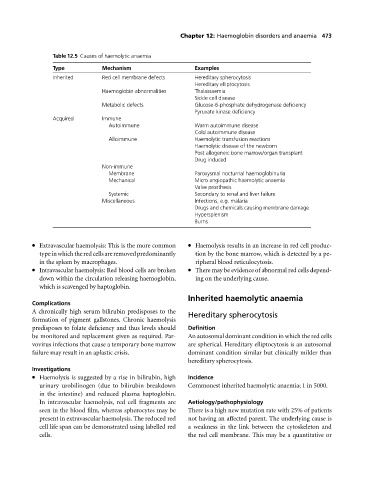Page 477 - Medicine and Surgery
P. 477
P1: KOA
BLUK007-12 BLUK007-Kendall May 12, 2005 20:37 Char Count= 0
Chapter 12: Haemoglobin disorders and anaemia 473
Table 12.5 Causes of haemolytic anaemia
Type Mechanism Examples
Inherited Red cell membrane defects Hereditary spherocytosis
Hereditary elliptocytosis
Haemoglobin abnormalities Thalassaemia
Sickle cell disease
Metabolic defects Glucose-6-phosphate dehydrogenase deficiency
Pyruvate kinase deficiency
Acquired Immune
Autoimmune Warm autoimmune disease
Cold autoimmune disease
Alloimmune Haemolytic transfusion reactions
Haemolytic disease of the newborn
Post allogeneic bone marrow/organ transplant
Drug induced
Non-immune
Membrane Paroxysmal nocturnal haemoglobinuria
Mechanical Micro angiopathic haemolytic anaemia
Valve prosthesis
Systemic Secondary to renal and liver failure
Miscellaneous Infections, e.g. malaria
Drugs and chemicals causing membrane damage
Hypersplenism
Burns
Extravascular haemolysis: This is the more common Haemolysis results in an increase in red cell produc-
typeinwhichtheredcellsareremovedpredominantly tion by the bone marrow, which is detected by a pe-
in the spleen by macrophages. ripheral blood reticulocytosis.
Intravascular haemolysis: Red blood cells are broken There may be evidence of abnormal red cells depend-
down within the circulation releasing haemoglobin, ing on the underlying cause.
which is scavenged by haptoglobin.
Inherited haemolytic anaemia
Complications
Achronically high serum bilirubin predisposes to the Hereditary spherocytosis
formation of pigment gallstones. Chronic haemolysis
predisposes to folate deficiency and thus levels should Definition
be monitored and replacement given as required. Par- An autosomal dominant condition in which the red cells
vovirus infections that cause a temporary bone marrow are spherical. Hereditary elliptocytosis is an autosomal
failure may result in an aplastic crisis. dominant condition similar but clinically milder than
hereditary spherocytosis.
Investigations
Haemolysis is suggested by a rise in bilirubin, high Incidence
urinary urobilinogen (due to bilirubin breakdown Commonest inherited haemolytic anaemia; 1 in 5000.
in the intestine) and reduced plasma haptoglobin.
In intravascular haemolysis, red cell fragments are Aetiology/pathophysiology
seen in the blood film, whereas spherocytes may be There is a high new mutation rate with 25% of patients
present in extravascular haemolysis. The reduced red not having an affected parent. The underlying cause is
cell life span can be demonstrated using labelled red aweakness in the link between the cytoskeleton and
cells. the red cell membrane. This may be a quantitative or

